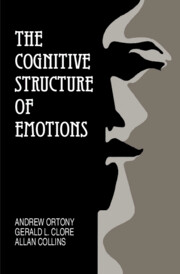Book contents
- Frontmatter
- Contents
- Preface
- 1 Introduction
- 2 The Structure of the Theory
- 3 The Cognitive Psychology of Appraisal
- 4 Factors Affecting the Intensity of Emotions
- 5 Reactions to Events: I
- 6 Reactions to Events: II
- 7 Reactions to Agents
- 8 Reactions to Objects
- 9 The Boundaries of the Theory
- References
- Author Index
- Subject Index
5 - Reactions to Events: I
Published online by Cambridge University Press: 01 June 2011
- Frontmatter
- Contents
- Preface
- 1 Introduction
- 2 The Structure of the Theory
- 3 The Cognitive Psychology of Appraisal
- 4 Factors Affecting the Intensity of Emotions
- 5 Reactions to Events: I
- 6 Reactions to Events: II
- 7 Reactions to Agents
- 8 Reactions to Objects
- 9 The Boundaries of the Theory
- References
- Author Index
- Subject Index
Summary
Having now dealt with the background issues, we move to our discussion of the distinct emotion types. We start by discussing the three main groups of emotions that involve reactions to events relative to one's own goals. The emotions in one of these groups result from considering the prospect of certain events occurring. These Prospect-based emotions will be discussed in Chapter 6. In this chapter we shall examine the other two groups of Event-based emotions, in which people's emotional reactions to events are more or less independent of their prior expectations. One of the groups that we shall discuss pertains to the fortunes of others and the reactions that one has to them. But first, we shall discuss what we call the “Well-being” emotions, with “joy” and “distress” being representative terms that refer to them. In distinguishing Well-being emotions from Prospect-based emotions, we do not intend to suggest that the degree to which events are unexpected is irrelevant for the Well-being emotions. Unexpectedness influences the intensity of all emotions. However, the Well-being emotions result from focusing attention on the events themselves rather than on events as tempered by the prospect of their occurring. As suggested in Chapter 2, these emotions are essentially “pure” cases of being pleased or displeased.
The Well-being Emotions
The internal structure of the Well-being emotions is quite simple.
- Type
- Chapter
- Information
- The Cognitive Structure of Emotions , pp. 85 - 108Publisher: Cambridge University PressPrint publication year: 1988



